Mechanical Technology: Welding and Metalwork Grade 12 Questions - NSC Exams Past Papers and Memos September 2019 Preparatory Examinations
Share via Whatsapp Join our WhatsApp Group Join our Telegram GroupINSTRUCTIONS AND INFORMATION
- Write your name on the ANSWER BOOK.
- Read ALL the questions carefully.
- Answer ALL the questions.
- Number the answers correctly according to the numbering system used in this question paper.
- Start EACH question on a NEW page.
- Show ALL calculations and units. Round off final answers to TWO decimal places.
- You may use a non-programmable scientific calculator and drawing instruments.
- The value of the gravitational force should be taken as 10 m/s2.
- All dimensions are in millimetres, unless stated otherwise in the question.
- A formula sheet is attached to the question paper.
- Write neatly and legibly.
- Use the criteria below to assist you with your time management.
QUESTION | CONTENT COVERED | MARKS | TIME |
Generic | |||
1 | Multiple-choice questions | 6 | 6 minutes |
2 | Safety | 10 | 10 minutes |
3 | Materials | 14 | 14 minutes |
Specific | |||
4 | Multiple-choice questions | 14 | 10 minutes |
5 | Terminology (Templates) | 23 | 20 minutes |
6 | Tools and Equipment | 18 | 10 minutes |
7 | Forces | 45 | 40 minutes |
8 | Joining Methods (Inspection of Weld) | 23 | 20 minutes |
9 | Joining Methods (Stresses and Distortion) | 18 | 20 minutes |
10 | Maintenance | 8 | 10 minutes |
11 | Terminology (Development) | 21 | 20 minutes |
TOTAL | 200 | 180 minutes |
QUESTIONS
QUESTION 1: MULTIPLE-CHOICE QUESTIONS (GENERIC)
Various options are provided as possible answers to the following questions. Choose the correct answer and write only the letter (A–D) next to the question numbers (1.1–1.6) in the ANSWER BOOK, for example 1.7 A.
1.1 Which of the following is NOT a basic first aid treatment?
- Examination
- Diagnosis
- Operate
- Basic comfort and safety (1)
1.2 Which ONE of the following items of personal protective equipment (PPE) is applicable when performing arc welding?
- Welding helmet
- Welding goggles
- Hard hat
- Dust mask (1)
1.3 Which of the following is a safety precaution in relation to the use of a bench grinder?
- The tool rest must be not more than 3 mm from the grinding wheel.
- Make sure the chuck is correctly tightened.
- Stand to the side when switching on the machine.
- Do not wear safety goggles. (1)
1.4 What is the colour of an oxygen gas cylinder?
- Maroon
- Grey
- Green
- Black (1)
1.5 Stopping devices on machinery are normally … in colour.
- red
- green
- black
- orange (1)
1.6 What is the maximum thickness of sheet metal that can be cut using a hand guillotine?
- 3,2 mm
- 1,6 mm
- 1,2 mm
- 2,1 mm (1) [6]
QUESTION 2: SAFETY (GENERIC)
2.1 Give TWO reasons why it is important to wear a helmet during arc welding.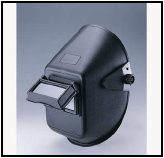 (2)
(2)
2.2 State TWO safety measures to be used when using an angle grinder. (2)
2.3 What is the maximum gap that the tool rest should be set from the grinding wheel of a bench grinder?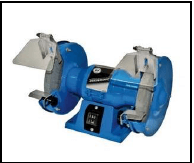 (1)
(1)
2.4 Give THREE safety rules to be applied when using a band saw. (3)
2.5 State TWO safety precautions that must be observed when handling gas cylinders.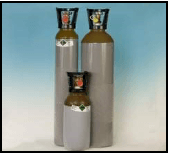 (2)
(2)
[10]
QUESTION 3: MATERIALS (GENERIC)
3.1 Explain what you understand about quenching during the heat treatment process.(3)
3.2 Why is brine better than fresh water in quenching heat-treated materials? (2)
3.3 State the purpose of case-hardening mild steel. (3)
3.4 Name TWO methods by which case-hardening can be done. (2)
3.5 Explain the difference between annealing and normalising. (4) [14]
QUESTION 4: MULTIPLE-CHOICE QUESTIONS (SPECIFIC)
Various options are provided as possible answers to the following questions. Choose the correct answer and write only the letter (A–D) next to the question numbers (4.1–4.14) in the ANSWER BOOK, for example 4.15 A.
4.1 Which ONE of the following safety procedures is applicable to the maintenance/operation of a hydraulic press?
- Do not apply a wrench to revolving work.
- Guards could be removed when pressing soft material.
- Pressure gauges must be tested regularly and adjusted or replaced if any malfunction occurs.
- Use the machine table as an anvil. (1)
4.2 Which ONE of the following safety measures applies to a power saw?
- Make sure that the cutting speed is set at the highest setting for the best performance.
- Long pieces of material must be supported at the ends.
- Make sure the blade is properly oiled.
- Tighten the blade while the machine is in motion. (1)
4.3 What is the purpose of the Occupational Health and Safety Act, 1993 (Act 85 of 1993) with regard to HIV/Aids awareness?
- The Act regarding safety states that all employers must make sure that the workplace is safe, and that employees are not at risk of becoming infected with HIV at work.
- The Act contains common guidelines on how employers, employees and trade unions should respond to HIV in the workplace.
- Employers may not demote or promote an employee based on his/her HIV status.
- Employers cannot simply dismiss a person who is infected with HIV. (1)
4.4 Which ONE of the following is NOT an advantage of the process layout of machines?
- High machine utilisation because more than one product is manufactured
- Better control of total manufacturing cost
- Control over operations is easier
- Greater flexibility in the production process (1)
4.5 Which of the following is NOT part of the definition of an accident?
- Unsafe conditions
- Controlled conditions
- Unplanned deeds
- Unsafe acts (1)
4.6 What safety measure is applicable to shears and guillotines in terms of workshop practices?
- Ensure that only trained and competent personnel use the machine
- Guards should be removed when cutting meta ls
- Do not use gloves when handling plates
- Choose the correct blade for the job (1)
4.7 Which of the following components is part of an electric angle grinder?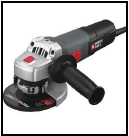
- Safety guard
- Stand
- Tool rest
- Grinding wheel dresser (1)
4.8 … is used to decrease the brittleness in hardened st eel.
- Annealing
- Tempering
- Hardening
- Normalising (1)
4.9 Which ONE of the following machines uses a reciprocating motion in its cutting process?
- Manual guillotine
- Grinding machine
- Power saw
- Vertical band saw (1)
4.10 Which ONE of the factors listed below is the most important when selecting the cutting speed of the drilling machine?
- Quality of cutting action
- Skill of the operator during drilling
- Type of material and cutting tool being use d
- Quality of machine being used (1)
4.11 When using the hydraulic press, at what angle (in degrees), must the load be applied to the work piece?
- 90°
- 45°
- 180°
- 60° (1)
4.12 Friction, while drilling a workpiece, can be reduc ed by …
- clamping.
- applying cutting fluid.
- increasing the speed.
- regular maintenance. (1)
4.13 Which formula would you use to calculate sinβ?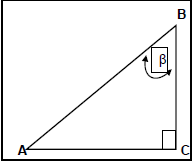
FIGURE 4.13
- sinβ = AC
AB - sinβ = BC
AB - sinβ = AB
AC - sinβ = AB (1)
BC
4.14 What will the strain be in a steel rod, which has been elongated by 0,5 mm under a tensile load, if its original length was 2 m?
- 0,5
- 0,25
- 0,25 x 10-3
- 0,025 x 10-3 (1) [14]
QUESTION 5: TERMINOLOGY (TEMPLATES) (SPECIFIC)
5.1 FIGURE 5.1 below shows a roof truss. Label parts A–E.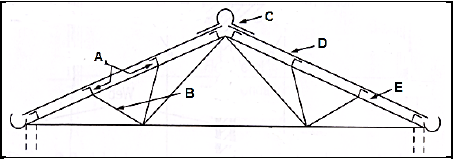
FIGURE 5.1 (5)
5.2 Make a neat sketch of a welding symbol indicating the following information on a T-Joint done with arc welding:
- The intermittent fillet weld on both sides is 8 mm in size
- The lengths of the weld beads are 40 mm each
- The pitch of the weld is 80 mm (7)
5.3 Calculate the length 75 x 12 mm regtangular sheet which is required to make the bearing casing shown in the figure.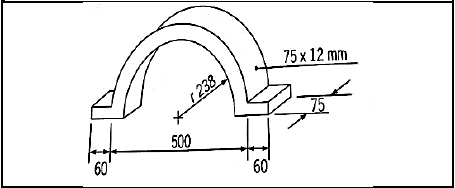 (6)
(6)
5.4 Name the THREE types of templates used in a template loft. (3)
5.5 Identify TWO tools used by the template makers. (2) [23]
QUESTION 6: TOOLS AND EQUIPMENT (SPECIFIC)
6.1 Why should oil never be applied to any components in an oxy-acetylene set up?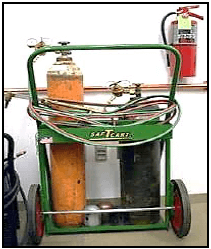 (1)
(1)
6.2 Name THREE main uses of a bench grinder. (3)
6.3 Explain the USES of the following:
6.3.1 Spot-welding equipment (3)
6.3.2 Punch and shearing machine (4)
6.4 Name THREE types rolling machines. (3)
6.5 What is the purpose of the three set screws on the round dies? (2)
6.6 Describe what the consequences would be if soft material such as aluminium, were grinded on a bench grinder. (2) [ 18]
QUESTION 7: FORCES (SPECIFIC)
7.1 Determine graphically the magnitude and nature of the forces in ALL the members in FIGURE 7.1 below.
SCALE: Space diagram 1 : 100
Vector/Force diagram 2 mm = 1 kN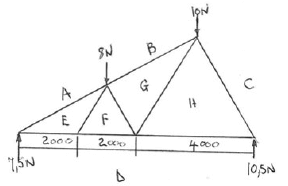
FIGURE 7.1 (20)
7.2 FIGURE 7.2 below shows a simply supported beam subjected to THREE-point loads.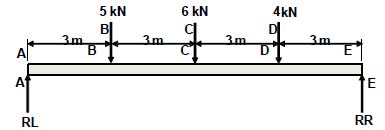
FIGURE 7.2
7.2.1 Calculate the reactions at the supports RL and RR. (6)
7.2.2 Calculate shear forces at points A, B, C, D and E. (5)
7.2.3 Calculate the bending moments at points A, B, C, D and E. (5)
7.2.4 Draw a shear force diagram of the beam. (4)
7.2.5 Draw a bending moment diagram of the beam.
10 mm = 1 m
SCALE:
Space diagram: 10 mm = 1 m
Shear force diagram: 5 mm = 1 kN
Bending moment diagram: 5 mm = 1 kN.m (5)
[45]
QUESTION 8: JOINING METHODS (INSPECTION OF WELD) (SPECIFIC)
8.1 What is welding spatter and how is it formed?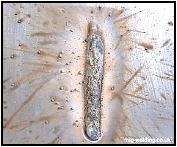 (4)
(4)
8.2 Describe the liquid dye penetrant test on a welded joint. (5)
8.3 State TWO causes for each of the welding defects:
8.3.1 Undercutting (2)
8.3.2 Slag inclusion (2)
8.3.3 Porosity (2)
8.3.4 Lack of fusion (2)
8.4 Name THREE factors that should be observed during the gas welding process to ensure a good welded joint.(3)
8.5 Name the TWO different types of cracks in welded joints. (2)
8.6 What is the purpose of a nick break test on a welded joint? (1) [23]
QUESTION 9: JOINING METHODS (STRESSES AND DISTORTION) (SPECIFIC)
9.1 What is weld distortion?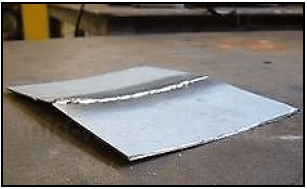 (2)
(2)
9.2 Name any THREE primary factors affecting distortion and residual stress. (3)
9.3 State THREE methods used to reduce distortion. (3)
9.4 Name the THREE main steel groups and state their carbon content percentage. (6)
9.5 Describe the difference between cold working and hot working of steel. (4) [18]
QUESTION 10: MAINTENANCE (SPECIFIC)
10.1 Discuss TWO reasons for locking out large machines before maintenance. (2)
10.2 Why do tagging plates have multiple holes? (1)
10.3 Compare the service requirements of a major and a minor service for a power- driven guillotine. (2)
10.4 State TWO general maintenance guidelines for a pedestal drilling machine. (2)
10.5 Mention ONE effect of overloading a punch and shearing machine. (1) [8]
QUESTION 11: TERMINOLOGY (DEVELOPMENT) (SPECIFIC)
11.1 FIGURE 11.1 below indicates a conical hopper. Calculate the following regarding the hopper: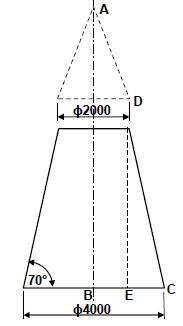
FIGU RE 11 .1
11.1.1 The vertical height (DE) (2)
11.1.2 The main radius (AC) (2)
11.1.3 The small radius (AD) (3)
11.1.4 The circumference (2)
11.2 FIGURE 11.2 below shows a square-to-round transition piece. In order to develop the transition, the true lengths must be calculated: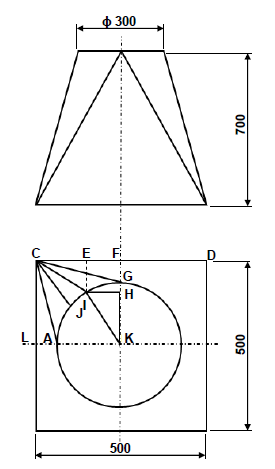
FIGURE 11.2
Determine the following true lengths with the help of calculations:
11.2.1 True length FG (5)
11.2.2 True length CI (4)
11.2.3 True length JI (3) [21]
TOTAL: 200
FORMULA SHEET FOR MECHANICAL TECHNOLOGY
(WELDING AND METALWORK)
